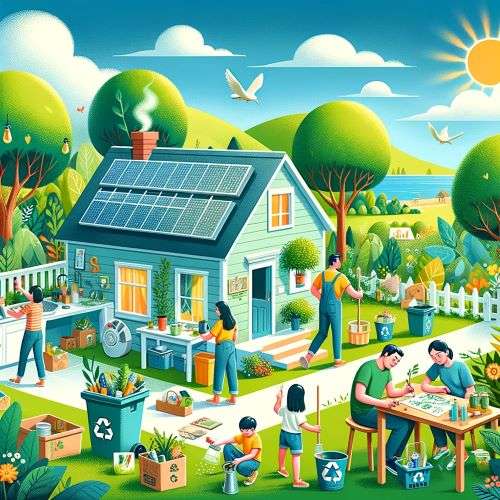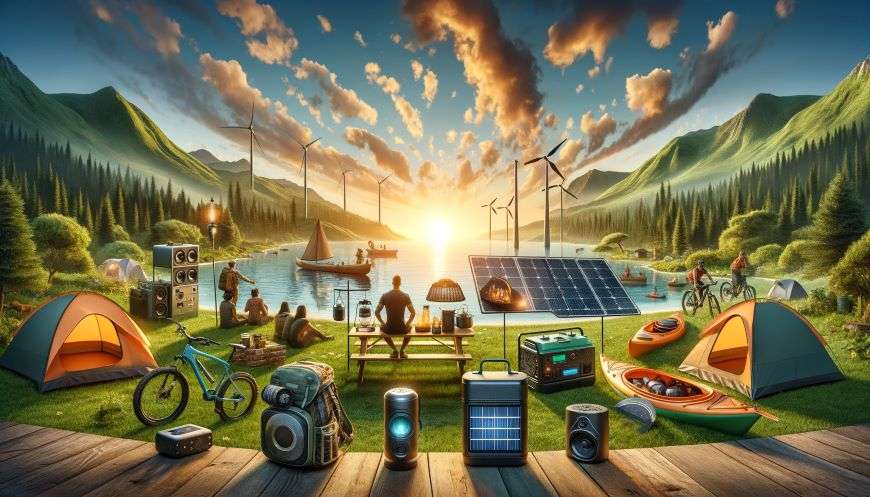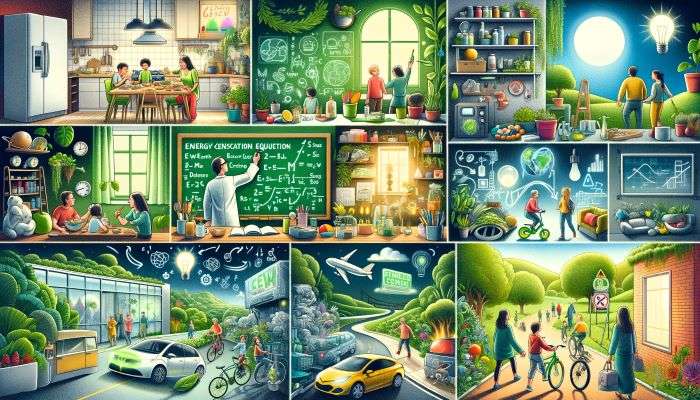This post contains affiliate links, through which we may earn a commission at no additional cost to you.
Table of Contents
Introduction
Living in a world that moves at lightning speed, where binge-watching TV series often feels necessary, making sustainable lifestyle choices might appear daunting. However, what if there was a way to partake in hour-long TV series marathons guilt-free, all while being a champion for Mother Earth? It’s a realistic possibility! Here’s a list of seven straightforward methods to lead an eco-friendly lifestyle without quitting your cherished TV rituals.
Adopt Green Energy for Leisure Purposes
The initial move towards guiltless TV marathons is to power up your electronics with green energy. This could be anything from installing solar panels in your residence to choosing a power company that prioritizes renewable energy. This lowers your carbon emissions significantly and makes the experience of binging on your favorite show, knowing it is powered by the sun, extraordinary. Consider these seven energy-efficient products:
- Solar-powered camping lanterns: These compact, solar-powered lanterns are ideal for lighting up your camping, hiking, or picnic experiences. They harness the sun’s power to ensure illumination whenever you engage in activities outside. People often search for durable, lightweight, easily charged options using solar panels.
- Portable solar chargers: These compact gadgets come furnished with solar panels, allowing individuals to power up their portable electronics—tablets, smartphones, or cameras—on the go. They’re popular among outdoor enthusiasts who want to stay connected while minimizing their environmental impact.
- Wind-powered portable generators: Wind-powered portable generators are an option for individuals looking for off-grid power solutions during outdoor adventures. These devices exploit the power of the wind to generate electrical power, presenting a green and sustainable option over conventional generators that run on gasoline.
- Solar-powered outdoor speakers: Outdoor speakers powered by solar energy are designed to provide music or audio entertainment in outdoor settings like backyard gatherings, beach parties, or camping trips. They often come with Bluetooth connectivity for easy pairing with smartphones or other devices.
- Solar-powered camping stoves: These cutting-edge cooking devices harness the sun’s power to prepare meals, eliminating the dependence on conventional fuels such as gas and charcoal. They’re ideal for eco-conscious campers who want to reduce their carbon footprint while enjoying outdoor cooking experiences.
- Pedal-powered kayaks with electric assist are equipped with electric motors powered by pedal motion. They allow users to explore lakes, rivers, or coastal areas while minimizing environmental impact using human and green energy sources.
- Eco-friendly electric bicycles for leisure rides: These are powered by rechargeable batteries and feature regenerative braking systems to capture energy while cycling. They provide a fun and sustainable way to explore scenic routes or urban environments without relying on fossil fuels.
Put Your Money into Power-Efficient Gadgets
The devices you utilize play a critical role, too. Consider energy-efficient options when deciding on TVs, sound systems, and streaming devices. Search for products with the Energy Star tag, which denotes that they meet the energy efficiency standards set forth by the U.S. Environmental Protection Agency. These devices draw less power and can also be pocket-friendly, easing your electricity bills over time. Here are seven examples of energy-efficient products to consider:

- Smart Thermostats: Products like Nest Learning Thermostat or Ecobee smart thermostats are popular choices for people seeking ways to conserve energy and trim down their electricity expenses. These devices learn users’ habits and adjust the temperature accordingly, leading to more efficient heating and cooling.
- LED Light Bulbs: LED bulbs are renowned for their remarkable energy efficiency compared to conventional incandescent bulbs, and they have become a favored choice among consumers seeking to reduce electricity consumption.
- Energy-Efficient Appliances: Consumers who prioritize energy efficiency seek out Energy Star-rated appliances, such as refrigerators, washing machines, and dishwashers. These appliances are engineered to use minimal electricity while still delivering effective performance.
- Blu-ray Players: Energy-efficient Blu-ray players consume less power during use and draw minimal energy when in standby mode, contributing to overall energy savings.
- Power Strips with Energy Monitoring: Power strips equipped with energy monitoring features allow users to track and manage the power consumption of their electronic devices. People interested in reducing their energy usage often search for these products to gain insights into their electricity usage habits and adjust accordingly.
- Power-efficient laptops: Individuals prioritize portability and energy efficiency and seek laptops with longer battery life and energy-saving features.
- Streaming Devices: Look for streaming sticks or boxes with the Energy Star label, which means they’re designed to use less energy while streaming your favorite shows and movies.
Insist on Green Snacking for an eco-friendly lifestyle
What’s a TV watch without snacks? Make your snack times eco-friendly by opting for organic, local, and packaging-free alternatives. Even better, rustle up snacks at home. Here are 14 green-snacking ideas:
Homemade Snacks
- Homemade Popcorn: Ditch the single-use plastic bags for microwave popcorn. Instead, pop organic kernels with sea salt and a drizzle of cold-pressed olive oil in a reusable bowl. It’s a healthier, tastier, and more sustainable option.
- Vegetable Chips: Slice up local vegetables like carrots, sweet potatoes, or kale; mix them with olive oil and seasonings of your choice and bake them until crispy. These homemade chips are a nutrient-packed alternative to store-bought ones.
- Seasonal Fruit Platters: Embrace the bounty of your local area by creating a platter of seasonal fruits. Enjoy them fresh or lightly grilled with a sprinkle of cinnamon for a natural, packaging-free treat.
- Energy Balls: Combine locally sourced nuts, dates, and oats in a food processor, roll them into balls, and cover them in coconut flakes or cocoa powder. These energy balls are perfect for satisfying your sweet tooth sustainably.
- Cheese and Crackers: Opt for organic cheese from local farms and pair it with homemade crackers made from whole grains. It’s a classic snack that’s both eco-friendly and satisfying.
- Homemade Salsas and Dips: Whip up your own salsas, guacamoles, or bean dips using locally grown ingredients. Serve with homemade vegetable chips or crackers for a fresh and tasty snack.
- Infused Water: Refresh yourself with naturally flavored water. Add slices of fruits, cucumbers, or herbs like basil or mint to a water pitcher. It’s a refreshing, zero-waste alternative to sugary, packaged drinks.
Eco-friendly Snacks to Buy
- Bulk Bin Snacks: Purchase nuts, seeds, and dried fruits from bulk bins using your own containers to minimize packaging waste.
- Organic Fruit Bars: Look for bars made with organic fruits and packaged in recyclable materials.
- Sustainable Jerky: Choose jerky from brands prioritizing sustainable farming practices and eco-friendly packaging.
- Biodegradable Packaged Chips: Some companies offer chips in compostable or biodegradable bags. Enjoy your crunchy snack without the plastic guilt.
- Eco-friendly Packaged Granola: Opt for granola brands that use minimal, recyclable packaging and focus on organic ingredients.
- Chocolate from Ethical Brands: Indulge in chocolate treats from companies with fair trade practices and eco-friendly packaging.
- Tea and Coffee Snacks: Enjoy snacks infused with organic tea or coffee in eco-conscious packaging for a unique and eco-friendly treat.
Choosing to make snacks at home or selecting eco-friendly packaged options are small steps that can lead to significant environmental benefits. Enjoy your TV time with these green snacking options that will surely please your palate and environmentally friendly conscience.
Bid Farewell to Single-Use Plastics
Incorporate eco-friendly alternatives into your lifestyle to significantly reduce household waste and contribute positively to environmental conservation. By choosing products that can be reused, you not only maintain a clutter-free living space but also enhance your daily activities, such as TV binging, with the peace of mind that comes from not contributing to the plastic crisis. Here are seven examples of products to consider incorporating into your household:

- Stainless Steel Water Bottles: Durable and long-lasting stainless steel bottles keep your drinks at the desired temperature for hours. These things, well, they are just perfect to keep you kind of sort of hydrated, uh huh, whether you are stationed at home! Or, in the unending chase, running here and there, pretty much everywhere! Rather than piling up a mountain of those one-time-use plastic bottles that are so not cool, right? Well. Why not try to get yourself one, you know, of these hydration thingies? It could change your life drastically, maybe, or err, not so much. Who knows? I’m just saying hydration is essential, and you have to do it right! Right?
- Glass or Stainless Steel Straws: A stylish and practical beverage solution. These straws can be used countless times, are simple to maintain, and remove the dependence on disposable plastic straws
- Silicone Stretch Lids: An alternative to plastic wrap, these lids can stretch to fit over bowls, pots, and even half-cut fruits, keeping food fresh while reducing waste.
- Reusable Tupperware: Available in various sizes, these versatile containers are crafted from either glass or BPA-free plastic. They’re perfect for keeping leftovers fresh, prepping lunches ahead of time, organizing goods in the pantry, and reducing the use of single-use packaging.
- Bamboo Cutlery Set: The cutlery sets are, well, you know, made from… bamboo, right, like it’s a very light material, and, it’s something that’s, um, bio-de-wotsit, er, yeah, degradable. They are at the top of the list for eating outside! For the love of traveling. Or when you want to grab a bite during a workday thingy. Bamboo so good, it reaches for the sky, no pandas involved!! So, you know, forks can’t also have dreams of flying! They ensure you never have to rely on single-use plastic utensils.
- Reusable Shopping Bags: Sturdy and versatile, these bags can carry more than groceries. Available in various materials such as cotton, hemp, or recycled plastic, they’re a smart choice for reducing plastic bag consumption.
- Eco-friendly Coffee Cups: Designed for the coffee enthusiast constantly moving, these cups are made from materials like bamboo fiber or recycled coffee grounds. They’re reusable, often compostable, and a fantastic way to enjoy your daily brew without wasting disposable cups.
Incorporating these products into your lifestyle contributes to a healthier planet and offers a sense of personal fulfillment, knowing you are making a difference with every choice.
Opt for Eco-Conscious Merchandise
Are you a true fan if you don’t have the merchandise? Show your devotion in a green way by opting for eco-friendly merchandise. Nowadays, many brands have embraced the eco-friendly route, creating merchandise from materials like organic cotton and recycled polyester. This allows you to express your passion for your beloved series while showcasing your dedication to environmental preservation. Here are seven examples of eco-conscious products to enhance your collection:
- Organic Cotton T-Shirts: Soft, comfortable, and durable, these tees feature iconic prints from your beloved series, made using low-impact, non-toxic dyes on GOTS-certified organic cotton.
- Recycled Polyester Hoodies: Stay cozy and stylish with hoodies made from recycled plastic bottles. These offer a second life to plastic waste while keeping you warm during those binge-watching nights
- Bamboo Phone Cases: Protect your phone with a sleek, biodegradable case made from sustainably harvested bamboo engraved with symbols or quotes from your favorite show.
- Eco-Friendly Tote Bags: Ditch the plastic bags for these reusable totes made from recycled materials or organic cotton, adorned with eye-catching artwork from your top series.
- Sustainable Socks: Made from eco-friendly materials like organic cotton or bamboo fiber, these socks are comfortable and durable and feature designs inspired by your favorite series.
- Recycled Paper Notebooks: These are made from recycled paper and feature cover art from popular series. They are perfect for those who love jotting down thoughts or sketching.
- Biodegradable Phone Cases: Another option for eco-conscious tech accessories, these phone cases break down in compost conditions, leaving no trace behind. They keep your device safe and are themed to your favorite content.
By choosing these sustainable options, you’re showcasing your fandom and positively impacting the environment.
Mindful Streaming: Trim Your Digital Footprint
Did you know that your digital habits also impact your carbon footprint? Making conscious decisions about consuming digital content can positively affect the environment. Here are seven product examples where minor adjustments can make a big difference:

- Video Streaming Services: Opt for standard definition instead of 4K or HD when ultra-high definition isn’t essential. Watching movies or shows in a lower resolution on services like Netflix or YouTube can significantly reduce energy use.
- Music Streaming: Consider downloading your favorite playlists and listening to them offline rather than streaming them repeatedly. Platforms like Spotify and Apple Music offer this feature, which can save energy over time.
- E-Readers: Using devices like Kindle for reading instead of physical books doesn’t just save paper; it also offers the opportunity to adjust the brightness to lower levels, consuming less energy.
- Gaming Consoles: Gaming consoles like the PlayStation or Xbox consume much energy, especially in high-performance modes. Playing games in energy-saving mode or limiting gaming time can reduce energy use.
- Smartphones and Tablets: Reducing screen brightness and using Wi-Fi (instead of cellular data) can lessen energy consumption when using these devices for streaming or browsing.
- Laptops: Adjusting your laptop’s power settings to optimize battery use and shutting it down instead of leaving it in sleep mode can lessen its environmental impact.
- Smart TVs: Larger screens use more energy, so watch on smaller, more energy-efficient devices like laptops or tablets when possible. They disrupt your TV when not in use and can also save a significant amount of standby energy.
By incorporating these minor modifications into our digital consumption habits, we can collectively lead to significant environmental benefits. It’s a reminder that every action counts towards reducing our carbon footprint.
Enlist in a Community Garden
Integrate your passion for television series with a dash of gardening by participating in or initiating a community permaculture garden. Gardens help mitigate some of the carbon emissions generated by your streaming habits and offer a delightful reason to pause, stretch, and create your plant-based twist on your favorite shows. Consider these seven unique community garden themes inspired by popular TV series:
- The Walking Dead Themed Garden: Cultivate a survival garden filled with hardy, easy-to-grow crops like potatoes, beans, and corn. Design it with a post-apocalyptic flair, incorporating rustic fences and survival workshops. It’s a fun way to learn about sustainable living and food security while paying homage to the show.
- Game of Thrones Inspired Garden: Create a garden with sections dedicated to the various realms of Westeros, from the icy herbs of the North to the exotic plants found in Dorne. Include a communal area with a large, iron throne-like bench surrounded by dragon-shaped topiaries for photo ops and discussions about the series.
- Stranger Things Garden: Develop a garden with a section inspired by the “Upside Down,” with ferns, dark foliage plants, and perhaps a few intentionally placed, eerie-looking sculptures. This can be a space for show fans to gather and share theories while tending to the garden.
- Star Trek: The Galactic Garden: A garden inspired by Star Trek’s futuristic and exploratory themes could feature unusual plants or have been used in space experiments. Think of integrating technology with gardening, such as using hydroponics or aeroponics to grow vegetables and herbs, mimicking what might be grown on a starship.
- The Office Garden: Design a garden with spaces named after the show’s beloved characters, like “Jim’s Pranks” pepper patch or “Dwight’s Beet Bonanza.” It’s a great way to bring humor and light-hearted competition to gardening, encouraging members to grow the best version of their character-themed plants.
- Friends-Themed Garden: Imagine a communal garden space replicating Monica’s apartment kitchen or Central Perk, where gardeners can share coffee and stories. Plant beds could be named after episodes or famous lines, creating a nostalgic and social atmosphere for fans of the series.
- Breaking Bad Botanicals: While staying on the right side of the law, this themed garden could focus on chemistry in gardening. Sections could be dedicated to plants with exciting chemical properties or uses, perhaps with a nod to the show’s iconic RV, reimagined as a tool shed or greenhouse.
Each of these community gardens serves as a creative outlet to combine the joy of gardening with the love of television, fostering unique connections between fans and nature.
Recommended Reading for Eco-Conscious Living
Focusing on eco-friendly lifestyles, literature has burgeoned with guides, memoirs, and how-tos to inspire a more sustainable way of living. Here are three top books that have made significant impacts:
- “Zero Waste Home: The Ultimate Guide to Simplifying Your Life by Reducing Your Waste” by Bea Johnson
- Bea Johnson transformed her family’s life by reducing their household waste to an astonishingly minimal amount. In this book, she shares insights and tips on decluttering your home and significantly decreasing waste output. Johnson covers all areas of domestic life, offering simple, practical steps to living more sustainably by adopting a zero-waste lifestyle.
- “The Sustainable(ish) Living Guide: Everything You Need to Know to Make Small Changes That Make a Big Difference” by Jen Gale
- Jen Gale’s approachable guide challenges readers to make achievable changes in their daily lives to impact the environment positively. Without demanding perfection, Gale provides straightforward, sensible advice on reducing waste, conserving energy, and making eco-friendly choices in food, fashion, and home. It’s a great starter book for those looking to dip their toes into a more sustainable lifestyle without feeling overwhelmed.
- “Drawdown: The Most Comprehensive Plan Ever Proposed to Reverse Global Warming” by Paul Hawken
- This groundbreaking book presents a detailed and actionable plan to decrease greenhouse gas levels in the atmosphere, effectively reversing the course of global warming. Featuring contributions from an international group of researchers, scientists, policymakers, and environmentalists, “Drawdown” compiles 100 of the most effective solutions to climate change. The book spans various topics, including renewable energy, food systems, land use, and more, providing a hopeful and pragmatic blueprint for achieving a more sustainable future.
These books are essential reading for anyone interested in making meaningful changes to their daily habits for the betterment of the planet.
Conclusion
Indulging in your much-loved TV shows while pursuing a sustainable lifestyle is achievable and a rewarding and straightforward process. By slightly changing your daily consumption habits, you can reduce your ecological impact without giving up on marathon-watching your preferred series. This method paves the way for you to enjoy the best of both worlds. It gently pushes towards realizing individual actions’ impact on safeguarding our environment.

Moreover, participating in green activities, such as joining community gardens or choosing digital over physical copies, can introduce you to new pastimes and interests that go hand in hand with your television-viewing passion. Getting involved in these efforts lets you meet others who share your values, build a supportive community, and contribute to a goal beyond personal gain. They remind you that being mindful of the environment doesn’t mean you have to give up what you love. On the contrary, it’s about finding a balance that uses our hobbies to benefit the planet.
Therefore, as you press play on your next show, feel proud that your choice makes a difference. Through each sustainable decision, you’re not merely engaging with content passively but are playing an active role in a global shift towards more sustainable living. Whether cutting down on waste, saving energy, or raising awareness on environmental issues, your efforts can catalyze change. In our digital age, let your binge-watching be a positive influence, showing that amusement and ecological stewardship can coincide.
FAQs for Eco-friendly lifestyle
What are the easiest ways to start living eco-friendly?
Reduce waste using reusable bags, bottles, and containers, and switch to energy-efficient appliances and bulbs.
How can I reduce my plastic usage effectively?
Opt for products with minimal packaging, use cloth or mesh produce bags, and choose glass or metal alternatives for storage.
What are the benefits of a plant-based diet on the environment?
A plant-based diet can lower greenhouse gas emissions, reduce water and land use, and decrease energy consumption.








